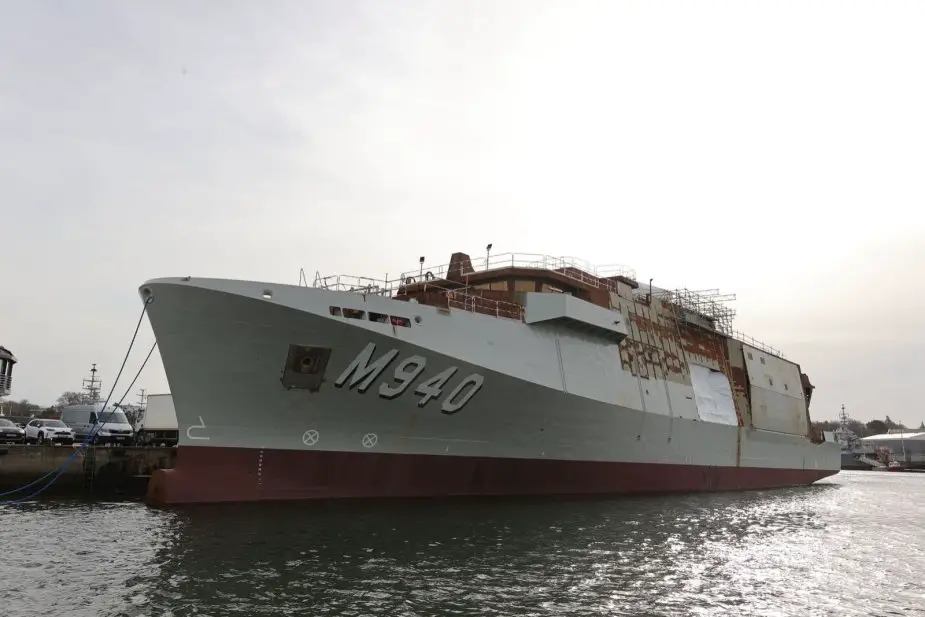Breaking news
Naval Group launches first Belgian Navy's City class MCMV Oostende.
According to a PR published by Naval Group on March 29, 2023, the first of the twelve mine countermeasure vessels of the Belgian Dutch rMCM program, the M940 Oostende intended for the Belgian Navy, was floated out in Concarneau.
Follow Navy Recognition on Google News at this link
 First City class Mine Countermeasure Vessel Oostende. (Picture source: Dutch MoD)
First City class Mine Countermeasure Vessel Oostende. (Picture source: Dutch MoD)
The launching ceremony took place in the presence of Ludivine Dedonder, Belgian Minister of Defence, Kajsa Ollongren, Dutch Minister of Defence, and Patricia Mirallès, French Secretary of State for Veterans and Memory. During this day, Naval Group also laid the keel for the third of the twelve vessels, the M941 Tournai, intended for the Belgian Navy.
This program was awarded in 2019 to Belgium Naval & Robotics, the consortium formed by Naval Group and Exail, following an international competition.
It provides for the supply to the Belgian Navy and the Royal Netherlands Navy of twelve mine countermeasures vessels and around a hundred drones integrated inside a toolbox that will equip the vessels.
The first delivery is scheduled for the end of 2024 in Zeebrugge, Belgium. Deliveries will then be staggered until 2030.
A unique industrial and European partnership
Naval Group, as overall architect and prime contractor, is responsible for the design of the ships, the overall integration, and the testing and commissioning of the mission system (combat system and mine countermeasures system).
Kership, a joint venture between Naval Group and Piriou, is in charge of the production of the twelve vessels which are assembled in Concarneau and Lanester. Exail Robotics, as co-contractor, is in charge of the unmanned drones’ system.
Most of these drones will be produced in Exailfactory (Ostend, Belgium). The maintenance of the ships will be carried out in Belgium in close collaboration between the Belgian Navy and Naval Group Belgium, with the assistance of its partner Flanders Ship Repair.
The rMCM program is also a major element of European Defence. This program demonstrates that European countries can work together to define their needs and share a solution that is destined to become a reference in the mine countermeasures field, not only for the Belgian and Dutch navies, but also for other navies in Europe and around the world.
Belgium, an industrial center of excellence for Naval Group and Exail in mine countermeasures
Within the framework of this strategic partnership, Naval Group, and Exail are developing their presence in Belgium through dedicated structures, Naval Group Belgium and Exail Belgium.
Belgian industry's added value is maximized through the rMCM program, starting from the design, development, and operational support phases, notably through procurement and subcontracting operations with Belgian companies on critical ship equipment. As an example, Exail Belgium will develop, produce, assemble, and qualify the toolbox in Belgium.
The involvement of the Belgian industry in the program also concerns R&D projects carried out in Belgium to prepare the future of mine countermeasures.
On April 28th 2022, Naval Group inaugurated the MCM Lab and the Cyber Lab, two collaborative R&D laboratories created within its subsidiary Naval Group Belgium.
The Labs bring together Belgian institutional, industrial, and academic partners to develop tomorrow's innovations in the field of mine countermeasures and cyber security.
A resilient vessel and a latest generation toolbox
These specialised and cyber secured by design mine countermeasures (MCM) vessels are the first to have the capability to embark and launch a combination of surface drones (themselves 12-meter, 18-tonne vessels), underwater drones, and aerial drones.
The mine countermeasures vessels will use a mainly autonomous system for detection, classification, and neutralization of mines. They can withstand underwater explosions and have very low acoustic, electrical, and magnetic signatures, in line with the missions to be carried out.
The solution acquired by the Belgian and Dutch navies is a complete paradigm shift in the way mines are fought by adopting a remote position (stand-off) which reduces the risk for personnel and the mothership and allows a substantial increase in the speed of coverage of mined areas.
Technical data
The vessel has a length of 82.6 meters and a width of 17 meters, with a displacement of 2800 tonnes. The maximum speed of the MCMV is 15.3 knots, and it has a range of over 3500 nautical miles. The base crew of the vessel is 33 people, with a total crew of 63 people.
The MCMV is equipped with the Naval Group Polaris combat system, which is used for mine detection and destruction. The vessel also has advanced drone capabilities, including the Exail UMISOFT system, 2 unmanned surface vehicles (Exail Inspector 125), 3 autonomous underwater vehicles (A-18 equipped with Exail UMISAS 120 sonar), 2 towed sonars (T-18 equipped with Exail UMISAS 240 sonar), 2 Mine Identification & Disposal Systems (MIDS) systems (Exail Seascan and K-Ster C), 1 unmanned aerial vessel (UMS Skeldar’s V200), and 1 Exail influence mine sweeping system integrating 5 CTM magnetic modules and 1 PATRIA acoustic module.
In terms of handling, the MCMV has 2 side launch & recovery systems for surface drones or commando boats, a 15-ton dedicated rear crane, and a 3-ton overhead crane. The vessel also has an embarkation capacity of 2 SOLAS rigid hull inflatable boats of 7 meters.




























